If you see Not enough memory to run Microsoft Excel error while launching Excel, then the solutions provided in this article may help you fix it. This error prevents users from working in Microsoft Excel because they can’t open any spreadsheet. Some users have seen this error while attaching an Excel file in Microsoft Outlook or while opening an Excel file from Outlook and from another email client.
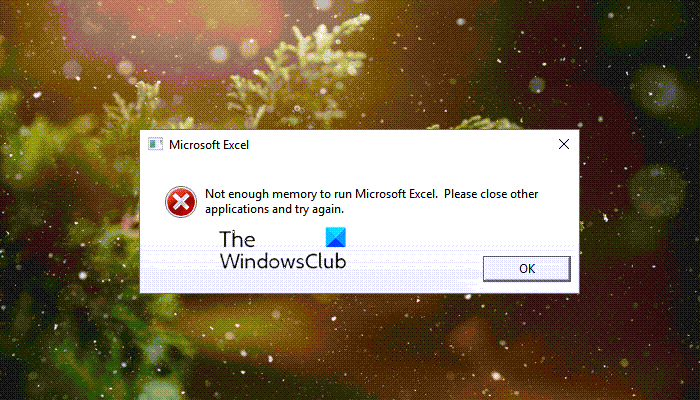
The complete error message is as follows:
Not enough memory to run Microsoft Excel. Please close other applications and try again.
Not enough memory to run Microsoft Excel
The following fixes will help you get rid of this problem. Before you proceed, close other running applications and see if you can open Microsoft Excel. If not, restart your computer and check if the issue is fixed.
- Run Excel as an administrator
- Make the Excel folder empty
- Change your default printer
- Troubleshoot Excel in Safe Mode
- Troubleshoot your computer in a Clean Boot state
- Change the Trust Center settings
- Toggle the Dynamic Data Exchange (DDE) mode
- Check the status of the Windows Defender Firewall service
- Unblock the Excel file
- Turn off Preview Pane in File Explorer
- Delete temporary files and folders
- Repair Office
Below, we have explained all these fixes in detail.
1] Run Excel as an administrator
Sometimes the problem occurs due to administrative privileges. To check this, launch Microsoft Excel as administrator and then see if you get the same error message. To do that, right-click on the Microsoft Excel shortcut and select Run as administrator.
If this fixes your problem, you can make Excel always run as administrator.
2] Make the Excel folder empty
When you create a new spreadsheet or edit the existing one, Microsoft Excel creates its unsaved copy in the Excel folder. This is how Excel recovers your unsaved document when your computer or Excel crashes suddenly. These files remain in that folder until you save your spreadsheet. By default, these temporary files are located in the Roaming folder. Apart from that, some temporary cache files may also be created in that folder.
Make the Excel folder empty and check if this fixes your problem. To do that, follow the steps below:
- Open the Run command box by pressing the Win + R keys.
- Type %appdata% and click OK. This command will directly open the Roaming folder on your C drive.
- Now, open the Microsoft folder and then open the Excel folder. You may see some temporary files and folders there.
- Move all the files and folders to another location in order to make the Excel folder empty.
- Open Microsoft Excel and see if the problem disappears.
If the problem still occurs, you can move the files back to the Excel folder.
3] Change your default printer
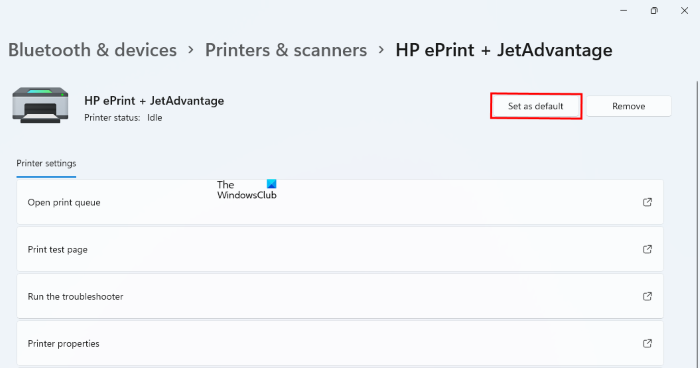
Sometimes, the problem occurs when Excel is not able to access the default printer. To check this, change your default printer. You can also make a virtual printer as your default printer, like Microsoft Print to PDF or Microsoft XPS Document Writer. After performing this step, check if the problem occurs.
4] Troubleshoot Excel in Safe Mode
There might be some problematic add-ins in Excel that are causing the problem. To check this, you have to troubleshoot Excel in Safe Mode. Check if you are able to launch Excel in Safe Mode. If yes, some of your Add-ins are the culprit.
To launch Excel in Safe Mode, open the Run command box and type excel /safe. After that, click OK. This will open Excel in Safe Mode. Now follow the steps below:
- Go to “File > Options.”
- Select Add-Ins from the left side.
- Click on the Manage drop-down and select COM Add-ins. Click Go.
- Deselect anyone add-in to disable it and click OK.
- Close Excel in Safe Mode and launch Excel in normal mode. See if the issue appears. If yes, repeat the above steps to disable another add-in and then launch Excel in normal mode again.
The above steps will help you find the problematic add-in. Once you find it, remove it from Excel.
5] Troubleshoot in a Clean Boot state
If there is no problematic add-in in Excel, the issue might occur due to a conflicting background or startup app. You can easily identify that program by starting your computer in a Clean Boot state. After starting your computer in a Clean Boot state, launch Microsoft Excel and see if the “Not enough memory to run Microsoft Excel” message appears. If not, there is a program that is conflicting with Microsoft Excel due to which Excel is displaying this error.
To identify that program, enable some of the disabled programs in the Clean Boot state, and then start your computer in a normal state. Launch Excel after starting your computer in the normal state and see if the error occurs. If yes, some of the programs you have just enabled are causing the problem. To identify those programs, disable the enabled programs one by one and launch Excel each time you disable a program. This will help you identify the problematic startup application.
Related: Excel is slow to respond or stops working
6] Change the Trust Center settings
If you are unable to attach an Excel in Outlook or if you are getting the error message after opening the Excel file from Outlook or another email client, change the Trust Center settings and see if it works.
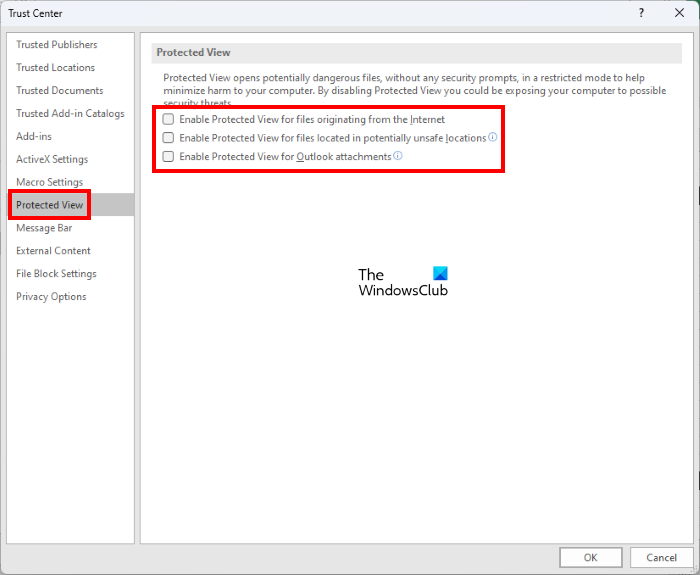
- Open Microsoft Excel.
- Go to “File > Options.”
- Now, go to “Trust Center > Trust Center Settings” and select Protected View from the left side.
- Uncheck all the options and click OK.
- Now, open the Trust Center Settings again and select File Block Settings from the left side.
- Uncheck all the options and click OK.
7] Toggle the Dynamic Data Exchange (DDE) mode
This solution is also for the users who are receiving the error message “Not enough memory to run Microsoft Excel” while attaching an Excel file to Outlook or while opening certain Excel files.
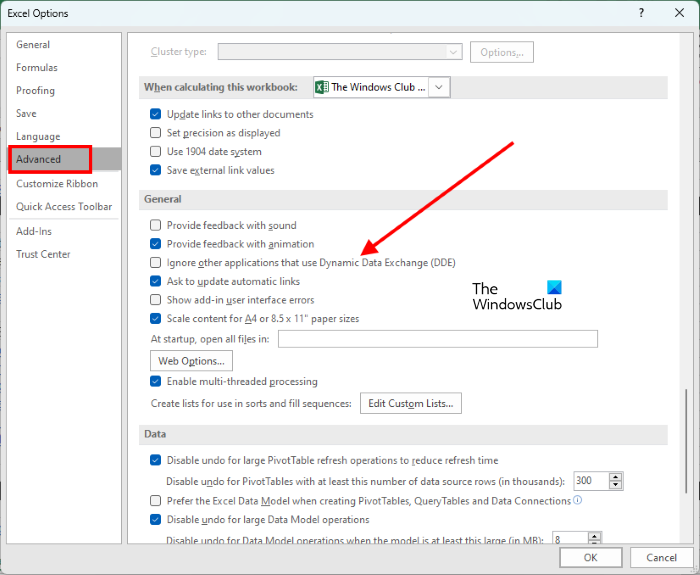
- Launch Microsoft Excel.
- Go to “File > Options > Advanced.”
- Scroll down until you find the General section.
- Enable the “Ignore other applications that use Dynamic Data Exchange (DDE)” option.
- Click OK and close Microsoft Excel.
- Wait for a few seconds and launch Excel again.
- Now, disable the “Ignore other applications that use Dynamic Data Exchange (DDE)” option.
- Click OK and close Excel.
This should help. If not, try the next solution.
8] Check the status of the Windows Defender Firewall service
For some users, starting the Windows Defender Firewall service fixed the issue. You should also try this. Open the Services app and check the status of the WIndows Defender Firewall service. If it is stopped, start it. The steps for the same are written below:
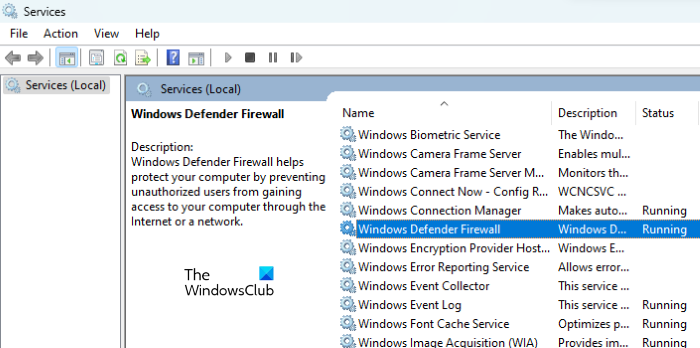
- Open the Run command box and type
services.msc. - When the Services app appears on your screen, locate the Windows Defender Firewall service.
- Its status should show Running. If it is stopped, double-click on it to open its properties.
- Click on the Startup type drop-down and select Automatic.
- Now, click Start to start the service.
- Click Apply and then click OK.
9] Unblock the Excel file
If you are getting the error message while opening some specific Excel files, you can try this fix. This method is also useful for users who are not able to open the Excel file from Outlook or another email client.
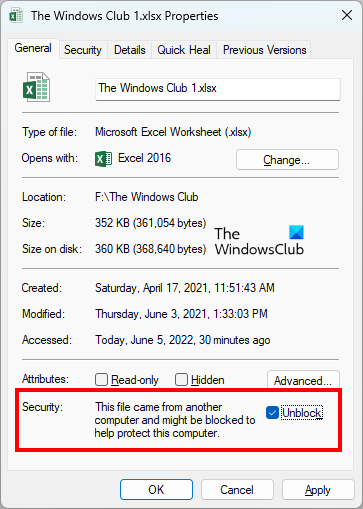
The steps to unblock an Excel file are written below:
- Right-click on the Excel file which is giving you the error.
- Select Properties.
- Select the General tab.
- Enable the Unblock option.
- Click Apply and then click OK.
Read: Fix VBA Run-time error Class not registered in Excel.
10] Turn off Preview Pane in File Explorer
Sometimes, the File Explorer’s Preview Pane causes problems on a Windows computer. The Preview Pane shows the preview of the files that you select. If it is enabled on your system, disable it and then check if you can open Microsoft Excel.
To disable the Preview Pane in Windows 10, open File Explorer and click on the View tab. Now, select the Preview Pane option to enable or disable it. In Windows 11, open File Explorer, then go to “View > Show” and uncheck the Preview Pane option.
If this works for you, you can permanently disable the Preview Pane in File Explorer via the Group Policy Editor and the Registry Editor.
11] Delete temporary files and folders
Another effective and easy solution that you can try is to delete the temporary files and folders. To do so, go through the following steps:
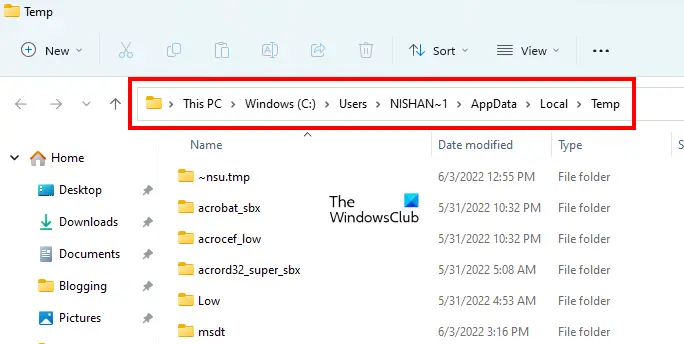
- Open the Run command box and type %temp%. Click OK.
- This command will open the folder containing temporary files and folders.
- Delete all the files and folders inside the Temp folder.
Now, open Microsoft Excel and see if the error message appears again.
12] Repair Office
If some of your Microsoft Office files get corrupted, you may experience several issues in different Office applications. If the problem that you are currently facing is occurring due to this, repairing the Office application can help. First, run the Quick Repair. If this does not help, run an Online Repair.
Read: Excel not scrolling smoothly or properly? Enable Excel smooth scrolling.
How do you fix There isn’t enough memory to complete this action in Microsoft Excel?
If you see the There isn’t enough memory to complete this action error in Microsoft Excel, first try to install the latest Windows Updates (if available). If this does not work, check if there is any add-in causing the problem. To do so, you have to troubleshoot Excel in Safe Mode.
Sometimes, problems occur when Excel is not able to access the default printer. Hence, another solution to fix this problem is to change the default printer. You can also try to launch Excel after disabling your antivirus.
How do I fix There is not enough memory or disk space to run in Excel?
Launch Excel as administrator and see if the issue appears. If yes, you have to try some other fixes, like troubleshooting Excel in the Safe Mode to identify the problematic add-in (if any), troubleshooting your computer in a Clean Boot state to find the conflicting application (if any), turning off the Preview Pane in File Explorer, etc. If nothing works, run an online repair or uninstall and reinstall Microsoft Office.
Hope this helps.
Read next: Cannot print from Excel? Fix Excel printing problems in Windows 11/10.
Leave a Reply